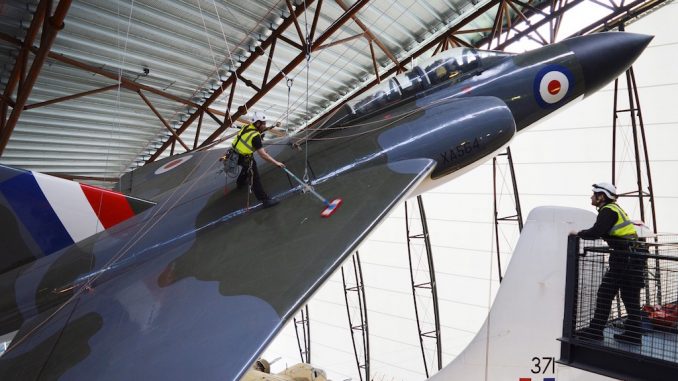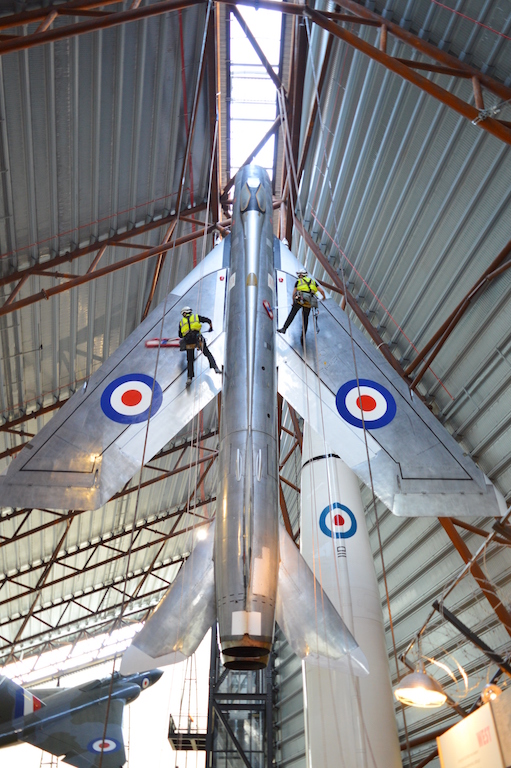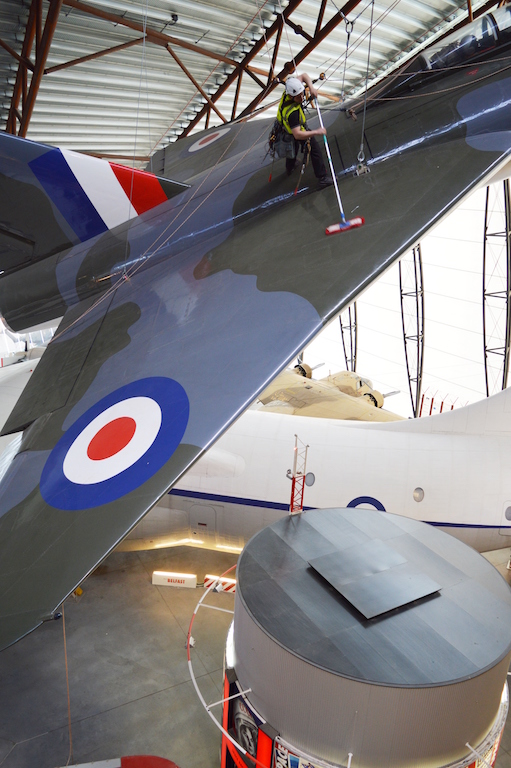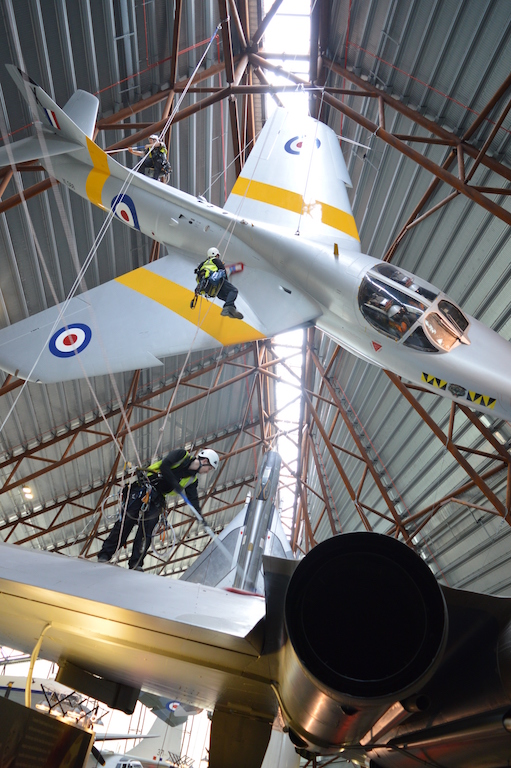
The annual high level aircraft cleaning will be taking place at RAF Museum Cosford from Tuesday the 2nd to Friday January 5th, 2018. The work will be focused on the suspended aircraft displayed within the Museum’s National Cold War Exhibition and will be carried out by Total Access, specialists in working at height. In addition to cleaning the aircraft, the Total Access team will also be carrying out safety checks on the suspension cables. Work will take approximately four days to complete and the media are invited to film and photograph the team at work during this period. Following an induction on the morning of January 2nd, the working hours for the team will be 9am to 4pm each day. Some of the aircraft involved in the cleaning operation will include iconic British jets such as English Electric Lightning P.1B/F-1 XG337, Gloster Javelin FAW.1 XA564, and Hawker Hunter T.7A XL568.

The museum’s English Electric Lightning P.1B, shown above, rolled off the production line at Warton, Lancashire in the late 1950s as the last of 20 pre-production F.1s to a 1954 contract No. 6/Acft/10351/CB7 (b). More commonly referred to as Development Batch aircraft, these Lightnings, in serial batch XG325 through XG337, took part in development and familiarization flights. Her first flight took place on September 5th, 1959 from nearby Samlesbury, Lancashire with J.K. Isherwood at the controls. As a pre-production aircraft, this Lightning was never intended to reach front line use, and spent it’s entire ten year flying career in trials and weapons development. XG337 sported an overall silver/natural metal finish during her service life, which ended in March 1969 following 698 flights totaling 476.25 hours in the air. For a more detailed look at her service history, please click HERE. XG337 has been on display in its dramatic vertical pose within the National Cold War Exhibition Building at RAF Museum Cosford since June, 2006.

Like Lightning XG337, the museum’s Gloster Javelin FAW.1 (shown above) spent its entire, albeit brief, flying career in development trials. This All Weather Fighter (hence the designation FAW) was part of an order for forty Javelin FAW.1s that the Royal Air Force ordered from the Gloster Aircraft Company in 1952 to contract 6/Acft/8336 (serialled XA544 – XA572 and XA618 to XA628). Gloster built XA564 at its factory in Hucclecote. Due to its rather unusual, delta winged shape, the Javelin received the rather apt moniker of ‘Flat Iron’. It was not a particularly successful design, as there were many development problems, and other aircraft, such as the Lightning, largely superseded its mission before the main flaws were conquered. Even so, the type, still engenders much affection from those who flew them. As intimated above, XG337 had a very short flying career, retiring to ground instructional use in July, 1957, just two years after her first flight. Interestingly, during her final posting, the aircraft served as a ground instructional airframe at RAF Cosford with the No.2 School of Technical Training. The airframe joined the RAF Museum collection in 1975, and sat on external display at Cosford until 2004 when she underwent a full restoration at the newly-opened Michael Beetham Conservation Center colocated at Cosford. Following her restoration, museum staff suspended XA564 from the ceiling in the brand new National Cold War Exhibition Building, again at RAF Museum Cosford.

Built by Hawker Aircraft Ltd at their Kingston factory (under contract number 6/Acft/12626) as one of the first production batch (XL563-XL579) of T.7 two-seat trainers, Hawker Hunter XL568 started service with the RAF in December 1957. The RAF eventually acquired 45 new-build T.7s, plus a further six converted from single seat F.4 fighter variants. This Hunter flew for the first time on April 6th, 1958. Interestingly, in July 1959, the museum’s Hunter took part and won the Daily Mail Bleriot Anniversary Air Race, between the Marble Arch in London and the Arc de Triomphe Paris, completing the journey in 40 minutes and 44 seconds. This Hunter had a long and distinguished career, which you can learn more about by clicking HERE. She didn’t formally retire until November, 1993. In April 2006, XL568 moved into the National Cold War Exhibition building at Cosford for suspended display.
Article based upon an RAF Museum press release.


Be the first to comment
Graphic Design, Branding and Aviation Art